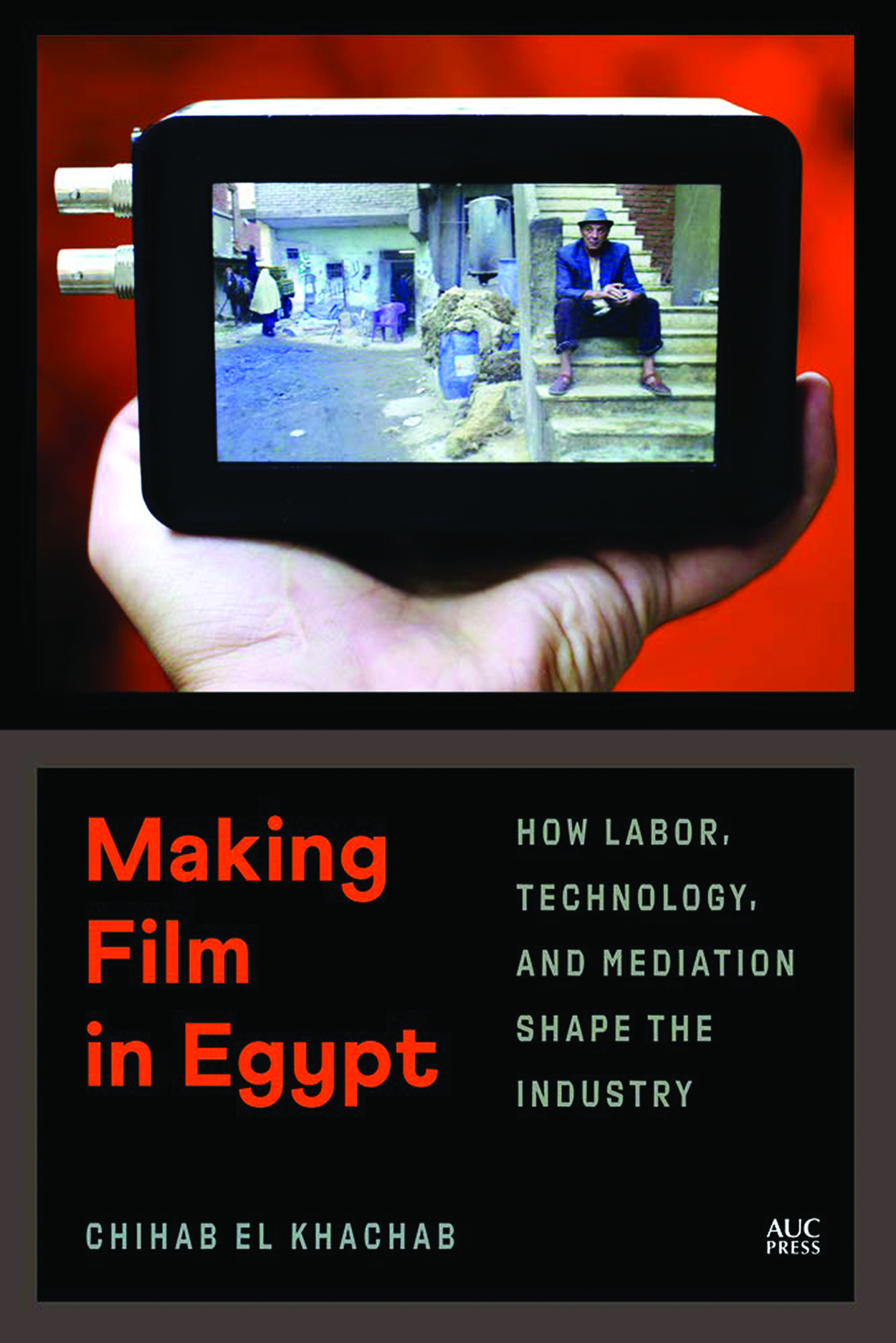In a chapter of Making Film in Egypt, Chihab El Khachab describes a film set under construction at Studio Misr one week before the shooting of the film Décor is supposed to begin. El Khachab followed the production of Décor during the 18 months of fieldwork he conducted in Cairo, scrutinizing the everyday activities that the film makers anticipated would ultimately culminate in the final film product. On this particular day, carpenters work on what is to be the interior of the protagonist’s apartment, sawing and sanding planks that will later be painted yellow. As this happens, the assistant art director asks the location manager when the ceramic tiles that he requested for the set would be purchased. The line producer grows upset upon hearing that the tiles have not yet been acquired, and a runner is immediately sent to get them. Meanwhile, members of the production team distribute and look over the first call sheets in the shooting schedule, preparing to advance to the next phase in the film’s production. As the day closes, the chief builder approaches the location manager for his team’s payments for the week. Concerned about the film’s budget, the assistant art director chides the chief builder for being behind schedule.
It is through textured and perhaps mundane descriptions of events such as these that El Khachab theorizes film production in his ethnography of the Egyptian film industry: as a process by which filmmakers mediate the unknown yet expected future. Combining media anthropology, media studies, and Middle East ethnography, El Khachab offers the temporal perspective of “expected futures” in his study of film production, a frame that departs from the extended present in which media production ethnographies are often written. In focusing on how filmmakers “attempt to overcome imponderable outcomes in everyday activity,”2 El Khachab presents a complex theoretical framework that encompasses all involved in the filmmaking process (such as the carpenters, location manager, builder, and runner in the previous paragraph) and nonhuman actors (planks of wood, call and budget sheets, in addition to cameras). With a book structure that gives a different sense of how filmmakers anticipate the future as each chapter unfolds, El Khachab examines the specificities of the inner-workings of the seldom-studied Egyptian film industry within the wider local and historical networks of which it is a part.
In the first three chapters, El Khachab details the ways in which mediating the imponderable future in filmmaking is a socio-technical process. In Chapter 1 (“Industry”), El Khachab maps the Egyptian film industry, the so-called Hollywood on the Nile, through a sketch of its history and current political and economic contours, and discussion of the slippery local distinctions between commercial and independent film production. He identifies two major changes that have impacted the industry since the turn of the century: first, a change in capital occurred in 2010 when major satellite channels in the Gulf stopped giving the distribution loans that were a major source of film production financing throughout the 2000s. The second change took place with the introduction of digital technologies. Most significantly for the following chapters of the book and his discussion of filmmaking as a socio-technical activity, El Khachab explains how interpersonal relationships undergird the organization of both the commercial and independent sides of the industry. As he explains, “it is difficult to gain access to the industry unless someone who ‘knows you’ allows you inside.”3
In Chapter 2 (“Process”) El Khachab elaborates on how interpersonal relationships shape the Egyptian film and how film workers mediate the imponderable future through three themes: labor hierarchies, apprenticeship, and operational sequence. Labor hierarchies are a model for work and interpersonal relationships among film workers in the industry, and El Khachab gives us a sense of how these hierarchies are constituted through distinctions such as those between creative and manual work. These hierarchies do not always mirror class and gender interactions in Cairo, and vertical mobility within the industry is more common than outside of it. Novice film workers acquire experience and know-how through hands-on, personalized, and embodied training through the patronage of their hierarchical superiors. This apprenticeship, as well as one’s place in the labor hierarchy, gives film workers a sense of the operational sequences in which they engage. Operational sequences are a method of managing the imponderable outcome of a film through the breakdown of filmmaking into a series of contingent tasks. The call sheets I referenced in the first paragraph are one of many ways in which film workers mediate the imponderable future.
Operational sequences, like film production in general, are inherently socio-technical in that they involve human and nonhuman actors like paper, cameras, teakettles, and other technologies. To conceptualize the relationship between human and nonhuman actors in the mediation of the imponderable future through operational sequences, El Khachab draws on and expands Heidegger’s notion of reserves in his reflection on technological objects in Chapter 3 (“Reserves”). An object, Heidegger theorizes, exists in two forms: in its objectness (the stuff that accounts for its existence) and as a reserve, “an entity dependent on a parallel world of reserves to exist as such.”4 The smartphone object is a mass of hardware and plastic that is programmed with a specific software. The smartphone reserve “is a device always readily available to summon audiovisual content.”5 Humans are also reserves; they summon smartphones as a communications-reserve, and smartphones, in turn, summon their attention to take pictures. As El Khachab explains, “this summoning anticipates the film’s imponderable outcome, while becoming ever more contingent on previous operations in the filmmaking process.”6
In the remaining chapters of the book, El Khachab builds on the theoretical framework he has established to show how filmmakers mediate three imponderable outcomes, each of which provides a title for the chapters. In “Coordination” (Chapter 4), El Khachab examines how shooting days are prepared in the Egyptian film industry within the realities of working in Cairo (such as traffic) through three logistical issues: budgeting, scheduling, and transportation. Labor hierarchies (discussed in Chapter 2) determine that these questions are largely left to the executive crew, while everyday artistic decisions are left to artistic workers such as the director. El Khachab details the imponderable process of visualizing a film in Chapter 5 (“Visualization”), analyzing how film workers use technological devices such as the video-assist monitor and scouting pictures to anticipate what the film will look and sound like through a series of contingent decisions. With their skill and authority, the director is assumed to have a complete vision of the film. Yet this vision is “distributed across a range of agents and mediators.”7 As part of visualizing the final film product, film workers consider the film’s imagined audience. In Chapter 6 (“Enchantment”), the book’s final chapter, El Khachab examines the practical effects that assumptions of a film’s future viewership have on the socio-technical activity of film production. In doing so, he explains assumptions common in the Egyptian film industry about various audiences and what they will or will not like.
Making Film in Egypt is an incredible tool in the way that El Khachab conceives of the relationship between human and nonhuman actors as they mediate the imponderable, socio-technical process of making a film. Its theoretical framework can travel usefully across temporal and geographical contexts. At times, the book’s wide claim to represent the whole Egyptian film industry seems tenuous, and its attempt to position itself with such authority is possibly symptomatic of Euro-American scholarship’s influence on the field and its history; it is as if film production in contexts such as Hollywood invite analysis through specifics, while the understudied Egyptian film industry can be claimed in wider brush strokes. In any case, El Khachab’s focus on the mundane aspects of filmmaking is part of a larger trend of “deflationary” turns in media studies that ask us to focus on less glamorous aspects of cinema and consider jobs and objects less commonly examined in the study of film industries. Although he may not call them out specifically in his book, the framework El Khachab proposes invites social critique and consideration of the labor inequalities, precarious work, environmental effects, and uneven gender dynamics that are often endemic to the filmmaking process.
Notes
- Dr. Claire Cooley is a postdoctoral fellow at Tufts University. Her research and teaching focus on film and media industries in the Global South, south–south media flows, sound studies, and critical infrastructure studies. Her work has appeared in a range of publications including Film History, Jump Cut, and Spectator. Her current book project, tentatively titled Sonic Infrastructures: The Emergence of National Cinemas in the Soundscape of al-Hind, tells the interconnected history of cinema in the Middle East and South Asia from the turn of the twentieth century to the 1960s. ⮭
- Chihab El Khachab (2021), Making film in Egypt: How labor, technology, and mediation shape the industry (p. 19). Cairo, NY: The American University in Cairo Press. ⮭
- Ibid., 6. ⮭
- Ibid., 14. ⮭
- Ibid. ⮭
- Ibid., 97. ⮭
- Ibid., 168. ⮭



